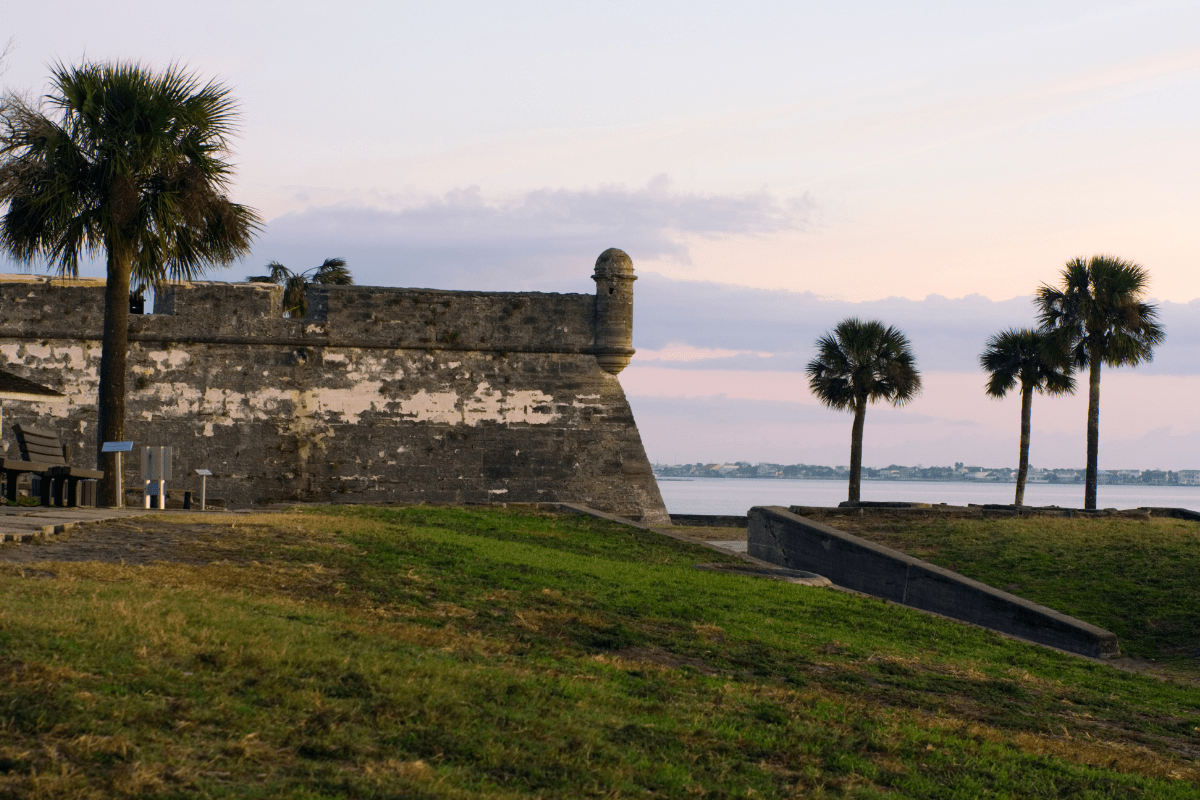Let's be honest: sometimes you need a break from Mickey Mouse and overpriced churros. Lucky for you, Florida has over 1,000 miles of scenic highways that'll make you forget all about those theme park crowds, showcasing everything from turquoise waters to moss-draped canopy roads that look straight out of a Southern Gothic novel.
The Overseas Highway: America's most ridiculous road trip
Picture this: you're driving across the ocean for 113 miles, hopping from island to island like some kind of automotive dolphin. The Overseas Highway from Key Largo to Key West isn't just a drive… it's basically a theme park ride that happens to use your own car.
What makes this drive legendary
The numbers alone are bonkers. You'll cross 42 bridges, including the famous Seven Mile Bridge that's been in approximately every car commercial ever made. Mile markers count down from 127 to 0, building anticipation like the world's slowest New Year's Eve countdown. While you can technically drive it in 3-4 hours straight, that's like wolfing down a gourmet meal. Most people need a full day because, well, there's stuff to see.
At Mile Marker 102, John Pennekamp Coral Reef State Park offers glass-bottom boat tours over America's first underwater park. It's like snorkeling for lazy people (no judgment, I'm one of them). Theater of the Sea at MM 84 lets you get uncomfortably close to dolphins, who always seem to be judging your life choices.
The secret route locals love
Here's a pro tip that'll make you feel like an insider: skip the traffic on US-1 and take Card Sound Road instead. Yes, there's a $1.50 toll, but it's worth it to cruise through Crocodile Lake National Wildlife Refuge without getting stuck behind some tourist doing 25 in a 55. Plus, you can stop at Alabama Jack's, a waterfront bar that hasn't changed since the 1950s and probably shouldn't. The floors are uneven, the drinks are strong, and the locals have the best stories.
Gulf Coast beach hopping on 30A
Welcome to Instagram heaven, also known as Scenic Highway 30A. This 24-mile stretch connects 16 beach communities, each trying to out-cute the next one.
The communities along 30A read like a real estate agent's fever dream. Seaside looks like someone built a town based on a Norman Rockwell painting, then added really expensive coffee shops. Alys Beach went full Mediterranean with stark white buildings that'll burn your retinas on sunny days. Rosemary Beach does the whole West Indies vibe, while Grayton Beach keeps it chill with that "I still shop at thrift stores" energy.
When to visit (and when to run away)
Timing is everything on 30A. The best kept secret is October, when the Gulf water is still warm but the crowds have gone back to Atlanta. Here's what to expect:
- June through August: packed and pricey
- March: spring break insanity
- September through November: perfection
- December through February: cooler but peaceful
- Any Saturday in summer: good luck parking
The parallel Timpoochee Trail offers 19 miles of paved cycling if you want to work off all those grouper sandwiches. Just remember that building heights are capped at 40 feet here, so no high-rise nightmares blocking your sunset selfies.
A1A: Where history meets beach hair
The A1A Scenic & Historic Coastal Byway runs 72 miles from Fernandina Beach to Flagler Beach, but let's talk about the elephant in the room: St. Augustine traffic.
Navigating America's oldest traffic jams
St. Augustine might be the nation's oldest city, but its traffic management apparently dates from the same era. The Vilano Bridge area turns into a parking lot every evening, with 25-minute delays that'll test your zen. Morning drives are your friend here.
But once you escape the congestion, oh boy. Fort Matanzas requires a ferry ride, which automatically makes it cooler than any fort you can just walk to. Washington Oaks Gardens State Park features ancient coquina rock formations that look like nature's own sculpture garden. Down south, you'll hit Palm Beach's Worth Avenue, where the parking meters probably cost more than your hotel room.
The Space Coast connection
Want to see a rocket launch without dealing with Kennedy Space Center crowds? Playalinda Beach Road at Canaveral National Seashore sits just 4 miles from the launch pads. The road has 13 parking areas with boardwalk access, though they fill up faster than a Black Friday sale during launches. The Apollo Beach section even has beach wheelchairs, proving that beach access should be for everyone.
Wildlife drives that'll make you forget zoos exist
Florida's wildlife doesn't just live in theme park exhibits. These drives put you right in their living rooms (respectfully, of course).
Tamiami Trail: Gator highway
The 74-mile Tamiami Trail through the Everglades is basically a nature documentary you drive through. At Shark Valley's 15-mile loop, alligators sunbathe mere feet from your car like scaly speed bumps. Winter months are prime time because water sources shrink, concentrating wildlife into smaller areas. It's like they're putting on a show just for you, except they definitely don't care that you exist.
Sanibel Island's wildlife refuge
First, let's address the elephant in the room: yes, the Sanibel Causeway costs $6. Yes, Hurricane Ian beat it up pretty badly. But the repairs wrapped up in 2024, and J.N. "Ding" Darling National Wildlife Refuge remains spectacular.
The refuge's 4-mile Wildlife Drive winds through 6,400 acres where 245 bird species hang out. Entry costs $10 per vehicle, which is basically nothing compared to theme park tickets. The refuge opens one hour before sunrise, perfect for photographers and insomniacs alike.
Lake Apopka: The weekend-only wonder
Here's a weird one: Lake Apopka Wildlife Drive only opens Friday through Sunday, 7am to 3pm. It's free, but they enforce a strict 10mph speed limit that makes your grandmother look like a speed demon.
This 11-mile route features 360 bird species and a 1940s pump house that survived the area's transformation from muck farms to wildlife paradise. Your car becomes a rolling blind, which means the birds don't freak out as much. Just don't try to pet anything.
Central Florida's unexpected gems
Not everything worth seeing in Florida involves sand or swamps. Central Florida hides some surprising scenic drives that most tourists miss completely.
Ocala National Forest: Bear country
State Road 19 through Ocala National Forest earned its "Florida Black Bear Scenic Byway" designation honestly. Bears regularly cross the road, especially during early morning drives. The 50-mile route between Umatilla and Palatka also features crystal-clear springs maintaining a constant 72°F, because Florida springs don't believe in seasons.
Notable springs along the route:
- Alexander Springs: scuba diving allowed
- Silver Glen Springs: Instagram-famous palm tree
- Juniper Springs: perfect for swimming
- Salt Springs: mineral-rich soaking
Wildflowers peak in March and April, but avoid summer unless you enjoy feeling like a rotisserie chicken. Also skip November through January unless you want to share the forest with hunters.
The Ridge Scenic Highway: Florida's "mountains"
OK, calling them mountains is generous, but the Ridge Scenic Highway between Lake Wales and Haines City does showcase Florida's highest elevations. Sugarloaf Mountain towers at a whopping 312 feet, which is basically Everest by Florida standards.
Bok Tower Gardens provides actual culture with its 1929 carillon, while nearby Spook Hill creates an optical illusion where cars appear to roll uphill. It's either magic or science, depending on how many mai tais you had at lunch. The annual 39-Mile Scenic Highway Yard Sale each November turns the whole route into Florida's longest shopping experience.
Hidden drives for people who hate crowds
Some of Florida's best drives barely show up on tourist radars, which is exactly why you should know about them.
Big Bend Scenic Byway: The Forgotten Coast
This 220-mile route along the "Forgotten Coast" lives up to its name. Between Bald Point State Park and Apalachicola, you'll find 40 miles of undeveloped coastline where black bears cross roads near Tate's Hell State Forest.
Wakulla Beach Road leads to a hard-packed sand beach populated by thousands of fiddler crabs doing their weird little crab dance. October brings monarch butterflies migrating through, turning the whole area into a Disney movie that Disney didn't make.
Gasparilla Island: Old Florida money
The causeway to Gasparilla Island costs $6, but it buys you entry to Boca Grande's time warp. Banyan trees planted in 1915 create cathedral ceilings over streets lined with white picket fences that probably cost more than your car.
This place claims the title "Tarpon Capital of the World," with peak fishing from May through August. Even if you don't fish, watching rich people get excited about fish is surprisingly entertaining.
Tallahassee's canopy roads
Nine canopy roads totaling 78 miles prove that North Florida is basically South Georgia with better marketing. Miccosukee Road's 9-mile continuous canopy started as a Native American footpath and served 30 plantations by the 1850s. Now it serves Instagram photographers and couples looking for wedding venues.
When to hit the road (and when to stay home)
Florida's seasonal timing can make or break your scenic drive experience. Here's the real deal on when to visit.
The local's guide to seasonal timing
Locals universally recommend September through November and January through March for the sweet spot of good weather and fewer crowds. Hurricane season runs June through November, peaking August through October. Yes, you might get rained on, but you'll also get cheaper hotels and emptier beaches.
Wildlife has its own calendar:
- Sea turtle nesting: May through October
- Manatee congregation: November through March
- Tarpon fishing: May through August
- Monarch butterflies: October
- Wildflowers: March through May
Traffic reality check
Florida's worst traffic times are predictably 7-9am and 4-6pm on weekdays. A1A becomes a parking lot during afternoon beach exodus. Early morning drives aren't just better for photos… they're better for your sanity.
Final tips from someone who's made all the mistakes
After years of Florida road trips, here's what I wish I'd known from the start. Download offline maps before heading to remote areas like Loop Road, unless you enjoy the "no service" anxiety sweats. Keep water and sunscreen in your car year-round because Florida sun doesn't play.
Wildlife viewing requires patience and distance. Federal law requires staying 25 feet from Key deer, and trust me, they're not worth the fine. Those 10mph speed limits in wildlife areas? They're serious. Rangers have nothing better to do than write tickets.
Budget for tolls on Sanibel ($6), Gasparilla Island ($6), and Card Sound Bridge ($1.50). State parks usually charge $4-8 per vehicle, while National Wildlife Refuges run $5-10. Still cheaper than one day at Disney.
Most importantly, embrace the weird. Florida's scenic drives showcase a state that's part tropical paradise, part Southern Gothic novel, part wildlife documentary. Where else can you drive across 42 bridges to reach an island full of six-toed cats, or watch space rockets launch while standing on a beach, or dodge alligators on your morning commute?
These roads remind us that Florida is more than just theme parks and spring break stereotypes. It's a complex, beautiful, occasionally bizarre state where ancient oaks drape Spanish moss over historic roads, manatees gather in crystal springs, and yes, you really can drive across the ocean. So grab your sunscreen, queue up your Jimmy Buffett playlist (or don't, we won't judge), and hit the road. The mouse can wait.





